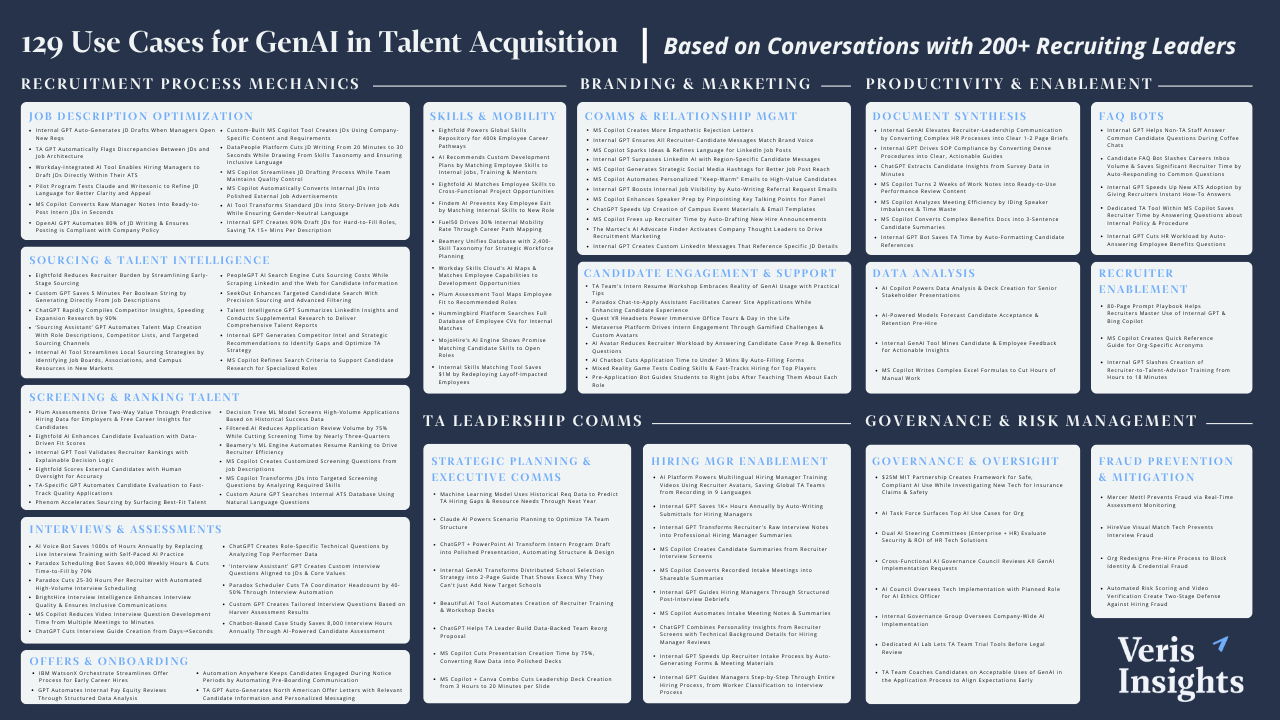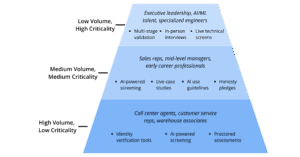AI has dominated Talent Acquisition (TA) conversations at every level over the past year, from gatherings among the nation’s top heads of TA, to strategy sessions with frontline recruiters.
With 92% of C-suite leaders viewing generative AI as key to business strategy, the pressure on recruiting leaders to leverage this technology has never been greater. Yet only 20% of TA teams feel “very” or “extremely prepared” to implement AI solutions, while over 50% report feeling “slightly prepared” or “not prepared at all”.
Vendors have painted grand visions of AI’s potential, promising sweeping changes to every aspect of recruiting. However, these promises have gone largely unfulfilled, which has left TA teams wondering: Where are the actual opportunities to drive ROI with AI?
Drawing on conversations with over 200 recruiting leaders, we set out to map the current landscape of AI solutions. The solutions we uncovered span an impressive range. Some operate across the entire recruiting lifecycle, while others are deliberately narrow in scope.
Some demand massive investment and bold organizational change, while others can deliver impact with little more than a subscription to ChatGPT.
Regardless of scope or complexity, they all share one quality: These are real solutions recruiting teams are using to drive value.

Recruitment Process Mechanics
Job Description Optimization
1. Internal GPT Auto-Generates Job Description Drafts When Managers Open New Requisitions
2. TA GPT Automatically Flags Discrepancies Between Job Descriptions and Job Architecture
3. Workday-Integrated AI Tool Enables Hiring Managers to Draft Job Descriptions Directly Within Their Applicant Tracking System (ATS)
4. Pilot Program Tests Claude and Writesonic to Refine Job Description Language for Better Clarity and Appeal
5. Microsoft Copilot Converts Raw Manager Notes Into Ready-to-Post Intern Job Descriptions in Seconds
6. OpenAI GPT Automates 80% of Job Description Writing & Ensures Posting is Compliant with Company Policy
7. Custom-Built MS Copilot Tool Creates Job Descriptions Using Company-Specific Content and Requirements
8. DataPeople Platform Cuts Job Description Writing From 20 Minutes to 30 Seconds While Drawing From Skills Taxonomy and Ensuring Inclusive Language
9. Microsoft Copilot Streamlines Job Description Drafting Process While Team Maintains Quality Control
10. Microsoft Copilot Automatically Converts Internal Job Descriptions Into Polished External Job Advertisements
11. AI Tool Transforms Standard Job Descriptions into Story-Driven Job Ads While Ensuring Gender-Neutral Language
12. Internal GPT Creates 90% Draft Job Description for Hard-to-Fill Roles, Saving TA 15+ Mins Per Description
Sourcing & Talent Intelligence
13. Eightfold Reduces Recruiter Burden by Streamlining Early-Stage Sourcing
14. Custom GPT Saves 5 Minutes Per Boolean String by Generating Directly From Job Descriptions
15. ChatGPT Rapidly Compiles Competitor Insights, Speeding Expansion Research by 90%
16. ‘Sourcing Assistant’ GPT Automates Talent Map Creation With Role Descriptions, Competitor Lists, and Targeted Sourcing Channels
17. Internal AI Tool Streamlines Local Sourcing Strategies by Identifying Job Boards, Associations, and Campus Resources in New Markets
18. PeopleGPT AI Search Engine Cuts Sourcing Costs While Scraping LinkedIn and the Web for Candidate Information
19. SeekOut Enhances Targeted Candidate Search With Precision Sourcing and Advanced Filtering
20. Talent Intelligence GPT Summarizes LinkedIn Insights and Conducts Supplemental Research to Deliver Comprehensive Talent Reports
21. Internal GPT Generates Competitor Intel and Strategic Recommendations to Identify Gaps and Optimize TA Strategy
22. Microsoft Copilot Refines Search Criteria to Support Candidate Research for Specialized Roles
Screening & Ranking Talent
23. Plum Assessments Drive Two-Way Value Through Predictive Hiring Data for Employers & Free Career Insights for Candidates
24. Eightfold AI Enhances Candidate Evaluation with Data-Driven Fit Scores
25. Internal GPT Tool Validates Recruiter Rankings with Explainable Decision Logic
26. Eightfold Scores External Candidates with Human Oversight for Accuracy
27. TA-Specific GPT Automates Candidate Evaluation to Fast-Track Quality Applications
28. Phenom Accelerates Sourcing by Surfacing Best-Fit Talent
29. Decision Tree ML Model Screens High-Volume Applications Based on Historical Success Data
30. Filtered.AI Reduces Application Review Volume by 75% While Cutting Screening Time by Nearly Three-Quarters
31. Beamery’s ML Engine Automates Resume Ranking to Drive Recruiter Efficiency
32. Microsoft Copilot Creates Customized Screening Questions from Job Descriptions
33. Microsoft Copilot Transforms Job Descriptions Into Targeted Screening Questions by Analyzing Required Skills
34. Custom Azure GPT Searches Internal ATS Database Using Natural Language Questions
Interviews & Assessments
35. AI Voice Bot Saves Thousands of Hours Annually by Replacing Live Interview Training with Self-Paced AI Practice
36. Paradox Scheduling Bot Saves 40,000 Weekly Hours & Cuts Time-to-Fill by 70%
37. Paradox Cuts 25-30 Hours Per Recruiter with Automated High-Volume Interview Scheduling
38. BrightHire Interview Intelligence Enhances Interview Quality & Ensures Inclusive Communications
39. MS Copilot Reduces Video Interview Question Development Time from Multiple Meetings to Minutes
40. ChatGPT Cuts Interview Guide Creation from Days to Seconds
41. ChatGPT Creates Role-Specific Technical Questions by Analyzing Top Performer Data
42. ‘Interview Assistant’ GPT Creates Custom Interview Questions Aligned to JDs & Core Values
43. Paradox Scheduler Cuts TA Coordinator Headcount by 40-50% Through Interview Automation
44. Custom GPT Creates Tailored Interview Questions Based on Harver Assessment Results
45. Chatbot-Based Case Study Saves 8,000 Interview Hours Annually Through AI-Powered Candidate Assessment
Offers & Onboarding
46. IBM WatsonX Orchestrate Streamlines Offer Process for Early Career Hires
47. GPT Automates Internal Pay Equity Reviews Through Structured Data Analysis
48. Automation Anywhere Keeps Candidates Engaged During Notice Periods by Automating Pre-Boarding Communication
49. TA GPT Auto-Generates North American Offer Letters with Relevant Candidate Information and Personalized Messaging
Skills & Mobility
50. Eightfold Powers Global Skills Repository for 400,000 Employee Career Pathways
51. AI Recommends Custom Development Plans by Matching Employee Skills to Internal Jobs, Training & Mentors
52. Eightfold AI Matches Employee Skills to Cross-Functional Project Opportunities
53. Findem AI Prevents Key Employee Exit by Matching Internal Skills to New Role
54. Fuel50 Drives 30% Internal Mobility Rate Through Career Path Mapping
55. Beamery Unifies Database with 2,400-Skill Taxonomy for Strategic Workforce Planning
56. Workday Skills Cloud’s AI Maps & Matches Employee Capabilities to Development Opportunities
57. Plum Assessment Tool Maps Employee Fit to Recommended Roles
58. Hummingbird Platform Searches Full Database of Employee CVs for Internal Matches
59. MojoHire’s AI Engine Shows Promise Matching Candidate Skills to Open Roles
60. Internal Skills Matching Tool Saves $1M by Redeploying Layoff-Impacted Employees
Branding & Marketing
Communications & Relationship Management
61. Microsoft Copilot Creates More Empathetic Rejection Letters
62. Internal GPT Ensures All Recruiter-Candidate Messages Match Brand Voice
63. Microsoft Copilot Sparks Ideas & Refines Language for LinkedIn Job Posts
64. Internal GPT Surpasses LinkedIn AI with Region-Specific Candidate Messages
65. Microsoft Copilot Generates Strategic Social Media Hashtags for Better Job Post Reach
66. Microsoft Copilot Automates Personalized “Keep-Warm” Emails to High-Value Candidates
67. Internal GPT Boosts Internal Job Visibility by Auto-Writing Referral Request Emails
68. Microsoft Copilot Enhances Speaker Prep by Pinpointing Key Talking Points for Panel
69. ChatGPT Speeds Up Creation of Campus Event Materials & Email Templates
70. Microsoft Copilot Frees up Recruiter Time by Auto-Drafting New Hire Announcements
71. The Martec’s AI Advocate Finder Activates Company Thought Leaders to Drive Recruitment Marketing
72. Internal GPT Creates Custom LinkedIn Messages That Reference Specific Job Description Details
Candidate Engagement & Support
73. TA Team’s Intern Resume Workshop Embraces Reality of GenAI Usage with Practical Tips
74. Paradox Chat-to-Apply Assistant Facilitates Career Site Applications While Enhancing Candidate Experience
75. Quest VR Headsets Power Immersive Office Tours & Day in the Life
76. Metaverse Platform Drives Intern Engagement Through Gamified Challenges & Custom Avatars
77. AI Avatar Reduces Recruiter Workload by Answering Candidate Case Prep & Benefits Questions
78. AI Chatbot Cuts Application Time to Under 3 Mins By Auto-Filling Forms
79. Mixed-Reality Game Tests Coding Skills & Fast-Tracks Hiring for Top Players
80. Pre-Application Bot Guides Students to the Right Jobs After Teaching Them About Each Role
Productivity & Enablement
Document Synthesis
81. Internal GenAI Elevates Recruiter-Leadership Communication by Converting Complex HR Processes into Clear 1-2 Page Briefs
82. Internal GPT Drives SOP Compliance by Converting Dense Procedures into Clear, Actionable Guides
83. ChatGPT Extracts Candidate Insights from Survey Data in Minutes
84. Microsoft Copilot Turns 2 Weeks of Work Notes into Ready-to-Use Performance Review Content
85. Microsoft Copilot Analyzes Meeting Efficiency by Identifying Speaker Imbalances & Time Waste
86. Microsoft Copilot Converts Complex Benefits Docs into 3-Sentence Candidate Summaries
87. Internal GPT Bot Saves TA Time by Auto-Formatting Candidate References
FAQ Bots
88. Internal GPT Helps Non-TA Staff Answer Common Candidate Questions During Coffee Chats
89. Candidate FAQ Bot Slashes Careers Inbox Volume & Saves Significant Recruiter Time by Auto-Responding to Common Questions
90. Internal GPT Speeds Up New ATS Adoption by Giving Recruiters Instant How-To Answers
91. Dedicated TA Tool Within MS Copilot Saves Recruiter Time by Answering Questions about Internal Policy & Procedure
92. Internal GPT Cuts HR Workload by Auto-Answering Employee Benefits Questions
Data Analysis
93. AI Copilot Powers Data Analysis & Deck Creation for Senior Stakeholder Presentations
94. AI-Powered Models Forecast Candidate Acceptance & Retention Pre-Hire
95. Internal GenAI Tool Mines Candidate & Employee Feedback for Actionable Insights
96. Microsoft Copilot Writes Complex Excel Formulas to Cut Hours of Manual Work
Recruiter Enablement
97. 80-Page Prompt Playbook Helps Recruiters Master Use of Internal GPT & Bing Copilot
98. Microsoft Copilot Creates Quick Reference Guide for Organization-Specific Acronyms
99. Internal GPT Slashes Creation of Recruiter-to-Talent-Advisor Training from Hours to 18 Minutes
Talent Acquisition Leadership Communications
Strategic Planning & Executive Communications
100. Machine Learning Model Uses Historical Requisition Data to Predict TA Hiring Gaps & Resource Needs Through Next Year
101. Claude AI Powers Scenario Planning to Optimize TA Team Structure
102. ChatGPT + PowerPoint AI Transform Intern Program Draft into Polished Presentation, Automating Structure & Design
103. Internal GenAI Transforms Distributed School Selection Strategy into 2-Page Guide That Shows Execs Why They Can’t Just Add New Target Schools
104. Beautiful.AI Tool Automates Creation of Recruiter Training & Workshop Decks
105. ChatGPT Helps TA Leader Build Data-Backed Team Reorg Proposal
106. Microsoft Copilot Cuts Presentation Creation Time by 75%, Converting Raw Data into Polished Decks
107. Microsoft Copilot + Canva Combo Cuts Leadership Deck Creation from 3 Hours to 20 Minutes per Slide
Hiring Manager Enablement
108. AI Platform Powers Multilingual Hiring Manager Training Videos Using Recruiter Avatars, Saving Global TA Teams from Recording in 9 Languages
109. Internal GPT Saves 1K+ Hours Annually by Auto-Writing Submittals for Hiring Managers
110. Internal GPT Transforms Recruiter’s Raw Interview Notes into Professional Hiring Manager Summaries
111. Microsoft Copilot Creates Candidate Summaries from Recruiter Interview Screens
112. Microsoft Copilot Converts Recorded Intake Meetings into Shareable Summaries
113. Internal GPT Guides Hiring Managers Through Structured Post-Interview Debriefs
114. Microsoft Copilot Automates Intake Meeting Notes & Summaries
115. ChatGPT Combines Personality Insights from Recruiter Screens with Technical Background Details for Hiring Manager Reviews
116. Internal GPT Speeds Up Recruiter Intake Process by Auto-Generating Forms & Meeting Materials
117. Internal GPT Guides Managers Step-by-Step Through Entire Hiring Process, from Worker Classification to Interview Process
Governance & Risk Management
Governance & Oversight
118. $25M MIT Partnership Creates Framework for Safe, Compliant AI Use While Investigating New Tech for Insurance Claims & Safety
119. AI Task Force Surfaces Top AI Use Cases for Org
120. Dual AI Steering Committees (Enterprise + HR) Evaluate Security & ROI of HR Tech Solutions
121. Cross-Functional AI Governance Council Reviews All GenAI Implementation Requests
122. AI Council Oversees Tech Implementation with Planned Role for AI Ethics Officer
123. Internal Governance Group Oversees Company-Wide AI Implementation
124. Dedicated AI Lab Lets TA Team Trial Tools Before Legal Review
125. TA Team Coaches Candidates on Acceptable Uses of GenAI in the Application Process to Align Expectations Early
Fraud Prevention & Mitigation
126. Mercer Mettl Prevents Fraud via Real-Time Assessment Monitoring
127. HireVue Visual Match Tech Prevents Interview Fraud
128. Organization Redesigns Pre-Hire Process to Block Identity & Credential Fraud
129. Automated Risk Scoring and Video Verification Create Two-Stage Defense Against Hiring Fraud


